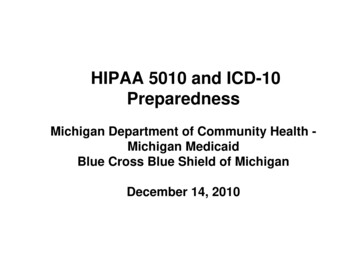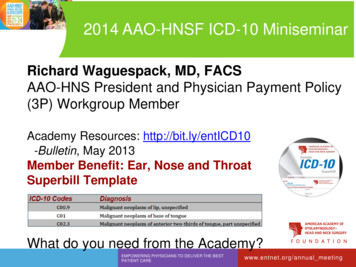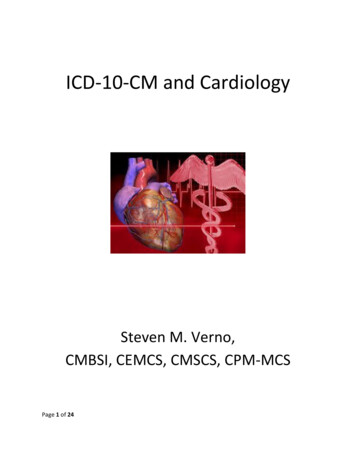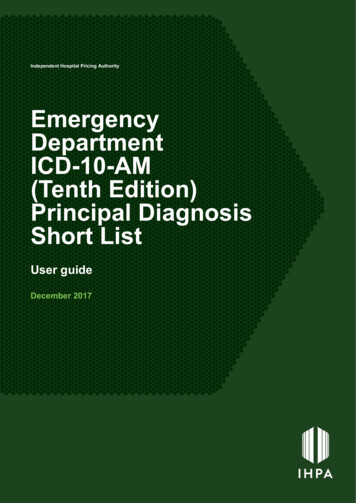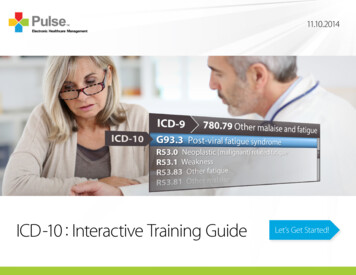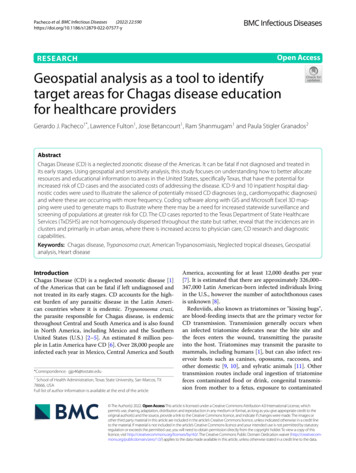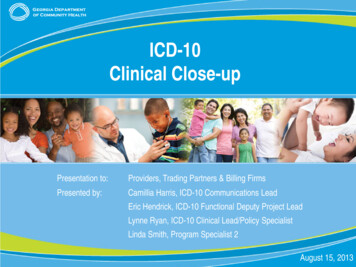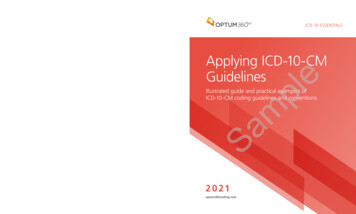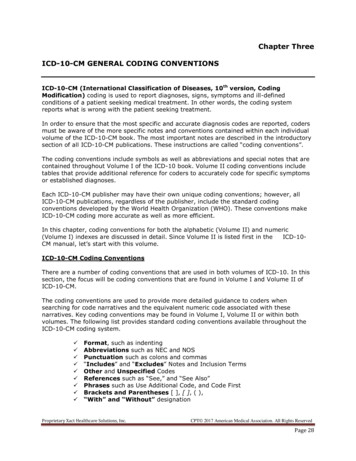
Transcription
Chapter ThreeICD-10-CM GENERAL CODING CONVENTIONSICD-10-CM (International Classification of Diseases, 10th version, CodingModification) coding is used to report diagnoses, signs, symptoms and ill-definedconditions of a patient seeking medical treatment. In other words, the coding systemreports what is wrong with the patient seeking treatment.In order to ensure that the most specific and accurate diagnosis codes are reported, codersmust be aware of the more specific notes and conventions contained within each individualvolume of the ICD-10-CM book. The most important notes are described in the introductorysection of all ICD-10-CM publications. These instructions are called “coding conventions”.The coding conventions include symbols as well as abbreviations and special notes that arecontained throughout Volume I of the ICD-10 book. Volume II coding conventions includetables that provide additional reference for coders to accurately code for specific symptomsor established diagnoses.Each ICD-10-CM publisher may have their own unique coding conventions; however, allICD-10-CM publications, regardless of the publisher, include the standard codingconventions developed by the World Health Organization (WHO). These conventions makeICD-10-CM coding more accurate as well as more efficient.In this chapter, coding conventions for both the alphabetic (Volume II) and numeric(Volume I) indexes are discussed in detail. Since Volume II is listed first in theICD-10CM manual, let’s start with this volume.ICD-10-CM Coding ConventionsThere are a number of coding conventions that are used in both volumes of ICD-10. In thissection, the focus will be coding conventions that are found in Volume I and Volume II ofICD-10-CM.The coding conventions are used to provide more detailed guidance to coders whensearching for code narratives and the equivalent numeric code associated with thesenarratives. Key coding conventions may be found in Volume I, Volume II or within bothvolumes. The following list provides standard coding conventions available throughout theICD-10-CM coding system. Format, such as indentingAbbreviations such as NEC and NOSPunctuation such as colons and commas“Includes” and “Excludes” Notes and Inclusion TermsOther and Unspecified CodesReferences such as “See,” and “See Also”Phrases such as Use Additional Code, and Code FirstBrackets and Parentheses [ ], [ ], ( ),“With” and “Without” designationProprietary Xact Healthcare Solutions, Inc.CPT 2017 American Medical Association. All Rights ReservedPage 28
ICD-10-CM Volume II Coding Convention DefinitionsVolume II coding conventions can be found throughout the alphabetic index within ICD10-CM. These coding conventions provide coders with additional guidance for choosing thecorrect Volume II narrative or phrase code lookup within a specific diagnosis category.Volume II may have one or more of the following symbols and/or additional instructioncodes.Symbols[ ] Brackets: Utilized to identify manifestation codes of the diagnosis code being reported(i.e. Alzheimer’s G30.9 [F02.80]).Subterms Yield: Sub-terms under the main category term may continue on next pageor column. Additional character required: Indicates code requires additional fourth, fifth, orsixth digit (the number is designated in the symbol).( ) Parentheses: Parentheses enclose supplementary words that may be present orabsent in the statement of a procedure or disease without affecting code assignment (i.e.:Conjunctivitis, (staphylococcal) (streptococcal)).NEC: “Not Elsewhere Classifiable” identifies codes and terms that are to be used only whenyou lack the information necessary to code the diagnosis to a more specific category. Thisagain is not justification for information not provided by a physician on an encounter formor when the diagnosis is not documented in the medical record. The NEC note indicates thatthe ICD-10-CM publication itself does not provide a more specific specification than the codebeing reported. The note may also indicate that the physician did not have enoughinformation to be more specific, such as the need to wait for old records to substantiate thepatient’s recollection of their diagnosis (i.e.: Complication, mechanical, implant, stent NECT85.698A)Instructional NotesNotes are listed throughout Volume II of ICD-10-CM. These notes are provided to assist thecoder in further defining included terms that the code reference refers to, so that the coderisn’t required to look up additional individual terms that would be included in the samenumeric code assignment (i.e.: Capsulitis (joint), adhesive, (shoulder) M75.0).Cross ReferencesSee: Directs you to a more specific term under which a correct or more specific code maybe found (i.e.: Leaky Heart – see Endocarditis).See Also: Indicates additional information is available that may provide an additionaldiagnostic code (i.e.: Median – see also condition).Default Code: In the alphabetic index, the default code that the narrative points to shouldbe used when there is no more descriptive code narrative to report the code.Proprietary Xact Healthcare Solutions, Inc.CPT 2017 American Medical Association. All Rights ReservedPage 29
An example would be an acute or chronic condition that is not documented as acute orchronic. Instead of the specific acute code or chronic code being reported, the default codewould be used.Volume II Alphabetic IndexICD-10-CM Volume I Coding Convention DefinitionsVolume I coding conventions can be found within each section of three-digit category codeswithin ICD-10-CM. These coding conventions provide coders with additional guidance forchoosing the correct Volume I numeric code within a specific diagnosis category. Codingconventions include specific symbols and instructional notes to aid the coder to code thediagnosis to the highest level of specificity allowed by the medical record documentationand narrative data available. Most of the ICD-10-CM coding instructions mirror those in ICDProprietary Xact Healthcare Solutions, Inc.CPT 2017 American Medical Association. All Rights ReservedPage 30
9-CM. Some have been expanded to accommodate the higher levels of detail in ICD-10-CM(i.e. excludes expanded to include excludes 1 and excludes 2).ICD-10-CM structural format changes include the expansion from five digit codes to up toseven digits. The following list provides a breakdown of this and other format changes tothe diagnosis coding system in Volume I. Valid codes may be 3-6 characters in length and are in BOLD typeface 4th character can be a letter or a number Codes longer than 3 characters have decimal point after first 3 characters (called acategory code) Must code to highest level of detail, using the codes fourth, fifth, sixth or seventhdigit where required Full code titles are used Coding conventions – excludes, code first and code alsoThree digit category codes may have one or more of the following additional instructioncodes.Symbols[ ] Brackets: Brackets enclose synonyms, alternate words, or explanatory phrases (i.e.Alzheimer’s G30.9 [F02.80]).: Colon: A colon is utilized after an incomplete term to provide more specific terms tomake the code assignable to the given categoryNew Code: Indicates new code for calendar year. Additional character required: Indicates code requires additional fourth, fifth, orsixth digit (the number is designated in the symbol). x7th Extension Alert: Provided for codes that require a seventh digit extension codeassignment for the numeric code.N Newborn: Age range birth-28 days. Indicates that the diagnosis is for a newborn orneonate only and should not be used if patient age does not fall into one of these categories(i.e.: fetal distress, prenatal jaundice).P Pediatric 0-17: Age range 0-17 years old. Indicates that the diagnosis is for a pediatricpatient only and should only be used if patient is a pediatric patient (i.e.: Reyes Syndrome,child wellness exam).M Maternity 12-55: Age range 12-55 years old. Indicates that the diagnosis is for amaternity patient to report conditions prevalent during and after pregnancydiabetes during pregnancy).Proprietary Xact Healthcare Solutions, Inc.(i.e.CPT 2017 American Medical Association. All Rights ReservedPage 31
A Adult: Age range 15-124 years old. Indicates that diagnosis is used to report conditionfor patient in adult age range with chronic or mental illness (i.e. senile delirium, maturecataract)Parentheses: While some parentheses enclose supplementary codes that do not affectcode assignment reference to Volume I, there are other parentheses that do affect codeassignment. Generally when code specificity is affected by the parentheses, there are one ortwo specific supplementary codes (in lieu of a larger list) that show the additional specificity.()Tip: Since a coder does not code directly from Volume II, the coder does not need to beconcerned about whether the supplemental codes listed in parentheses affect specificity ornot. These instructions are separated for the purpose of showing all uses for parentheses inVolume II so that the coder understands what the parentheses are representing. Revised Code Title: The code title has been revised for current year.Revised Text: The code text description has been revised and should be reviewed indetail to ensure the code assignment is not affected.Additional Instructional NotesExcludes 1 - Under a three digit category code, an Excludes 1 designation means that thecode is NOT CODED HERE and indicates that two codes are mutually exclusive andtherefore cannot be coded as separate codes in same encounter (example E66).*Coding Clinic Update- New 2017 ICD-10-CM guidelines state that two unrelatedcodes can be coded together even if an Excludes 1 note otherwise prohibits it.Example of Excludes 1 (related conditions)B06 Rubella [German measles]Excludes 1: congenital rubella (P35.0)- Code being excluded is never used with this code- The two conditions cannot occur togetherExample of Excludes 1 (unrelated conditions)G47.63 Sleep related bruxism (teeth grinding)Excludes 1: other somatoform disorders (F45.8)-Psychogenic dysmenorrheal is an inclusion term under F45.8, but can be coded withG47.63 because the two conditions are unrelatedExcludes 2 - Under a three digit category code, an Excludes 2 designation means that thecode is NOT INCLUDED HERE and indicates that the two codes, the categoryunder which the Excludes 2 code is listed and the Excludes 2 code listed, are distinctlyseparate and therefore can be coded together within the same encounter (example H21).Proprietary Xact Healthcare Solutions, Inc.CPT 2017 American Medical Association. All Rights ReservedPage 32
Example of Exclude 2Example: J04.0 Acute laryngitisExcludes 2: chronic laryngitis (J37.0)- Excluded condition is not part of the condition represented by the code- Acceptable to use both codes together if patient has both conditionsIncludes: Appears under three digit codes to better define or give examplesof contents of the specific category. The “includes” notes are not all inclusive notes; theyare only lists of examples for more detail on the types of conditions that are included in thecode category (i.e. F19).Not Otherwise Specified (NOS): Designates a code as non-specific and is used to refercoder to continue looking for a more specific code(s). The NOS codes are used when theprovider does not provide the details in the medical record documentation to assign a morespecific code. If the provider does not provide specific documentation to support specificity,the coder must report the NOS code.Not Elsewhere Classified (NEC): Used to direct the coder to an “other” or “otherspecified” code in the Tabular index. This designation is generally used when there is not amore specific diagnosis code that matches the medical record documentation.Code First/Use Additional Code: Appears where additional codes are needed to give amore complete picture of the diagnosis or procedure (example G06). This designation alsodirects the coder to code the condition designated as “code first” before the additionalsupplemental codes. “Use additional code” is listed under the three digit category code inred letters.Code First: Used to describe diagnoses that are not intended to be used as primarydiagnoses. The code, its title, and instructions appear in italics. The note requires that theunderlying disease be coded first and the condition that is being treated as the secondary.This is the only example of ICD-10 where the chief complaint or reason for visit is not theprimary diagnosis and is not listed first (I79.8).-Used when certain conditions have both an underlying etiology and multiple bodysystem manifestationsRequires the underlying condition be sequenced first followed by the manifestationProper sequencing order of the codes: etiology followed by manifestation (samecoding convention as ICD-9-CM)Code Also Notes/Use Additional Code-A “Code Also” note instructs that two codes may be required to fully describe acondition, but the sequencing of the two codes depends on the circumstances of theencounter.- Additional manifestation code notes include “use additional codes”In Diseases Classified Elsewhere-An “In Diseases Classified Elsewhere” note instructs that the condition being treated(manifestation) is caused by another disease; therefore, two codes may be requiredProprietary Xact Healthcare Solutions, Inc.CPT 2017 American Medical Association. All Rights ReservedPage 33
to fully describe the condition. Sequencing of the two codes depends on thecircumstances of the encounter.-Additional manifestation code notes include “in diseases classified elsewhere”With/Without Designation: This note in the Tabular Index is provided as an instructionalnote to designate that the additional numeric code is “associated with” or “due to” anothercondition. The fifth and sixth character designation for “with” and “without” are definedbelow. Fifth character code designation – 0 represents “without” if in the 5th position Fifth character code designation – 1 represents “with” if in the 5th position Sixth character code designation – 1 represents “with” if in the 6th position Sixth character code designation – 9 represents “without” in the 6th positionVolume I Tabular IndexNew ICD-10-CM Coding ConventionsWhile we can see that most of the coding conventions for the ICD-10-CM coding systemmirror those found in ICD-9-CM, there are some new additions to ICD-10-CM that havebeen added in order to allow more specific codes to be assigned where documentationsupports the specificity. These changes are included in Volume I and II. Therefore, we willdiscuss them together here. Where these changes affect specific code chapters in ICD-10CM, they will be revisited in more detail within the specific specialty chapter provided in themanual.Proprietary Xact Healthcare Solutions, Inc.CPT 2017 American Medical Association. All Rights ReservedPage 34
Laterality character designation is defined by numeric digits 0, 1, 2, 3, or 9. Thesecharacters are defined below. Laterality has been added to some ICD-10-CM diagnosis codecategories to show whether the diagnosis is affecting the left organ or anatomical site, rightorgan or anatomical site, bilateral organ or anatomical site, or if the organ or anatomicalsite is unspecified. Laterality is reported in the fifth or sixth digit space and is dependent onwhat code chapter and category is being reported.Laterality Character Designation by Digit Right side is character 1 Left side is character 2 Bilateral is character 3 Unspecified side is either a character 0 or 9, depending on whether it is a fifth orsixth characterExample of laterality code in ICD-10-CMH80.0 Otosclerosis involving oval window, nonobliterativeH80.00 Otosclerosis involving oval window, nonobliterative, unspecified earH80.01 Otosclerosis involving oval window, nonobliterative, right earH80.02 Otosclerosis involving oval window, nonobliterative, left earH80.03 Otosclerosis involving oval window, nonobliterative, bilateralSeventh character designation is utilized in ICD-10-CM to provide additional informationabout the encounter. The seventh character is only used in certain chapters of ICD-10-CM.The seventh digit is used in some chapters to define whether the encounter is the initialencounter, subsequent encounter or a sequela (late effect) encounter.Seventh Character Designation for Type of Encounter“A” - initial encounter is used while the patient is receiving active treatment for thecondition. Examples of active treatment are: surgical treatment, emergency departmentencounter, and evaluation and treatment by a new physician.“D” subsequent encounter is used for encounters after the patient has received activetreatment of the condition and is receiving routine care for the conditionduring the healing or recovery phase. Examples of subsequent care are: cast change orremoval, removal of external or internal fixation device, medication adjustment, otheraftercare and follow up visits following treatment of the injury or condition.“S”, sequela encounter is used for complications or conditions that arise as a direct resultof a condition, such as scar formation after a burn. The scars are a sequela, or a late effect,of the burn. When using 7th character “S”, it is necessary to report both the injury codethat precipitated the sequela and the code for thesequela or late effect. The “S” is added only to the injury code, not the sequela code. The7th character “S” identifies the injury responsible for the sequela. When coding for asequela, the sequela (e.g. scar) is sequenced first, followed by the injury code.Proprietary Xact Healthcare Solutions, Inc.CPT 2017 American Medical Association. All Rights ReservedPage 35
Placeholder X is used for codes that are only 3-5 digits long to ensure that the code thatrequires a seventh digit is able to be reported to the highest level of specificity. The X isadded to the 4th, 5th, and or 6th digit space so that the seventh digit code can be added tothe code assignment.Placeholder X may be used for any of the following scenarios: Used as placeholder to allow for further expansion of certain code series.“X” is used as placeholder to validate code usePoisoning, adverse effect and under dosing codes are examples of code sections thatutilize the “X” placeholderExample of X placeholderCode category T36 Poisoning by adverse effect requires a 7th character to determine if visitis the initial (A), subsequent (D) or sequela (late effect) (S) visit, however there is no 6thdigit character defined for this code.T36.96XA (the X is the placeholder so that the required 7th digit may bereported)Specific Chapter Coding Guidelines for ICD-10-CMCoding for DiabetesDiabetes mellitus is a chronic condition that causes high blood sugar levels over prolongedperiods. There are three main categories or types of diabetes: type I, type II andgestational diabetes. Code descriptions for type I and type II diabetes describe the type ofdiabetes that the patient has and whether the diabetes is controlled or uncontrolled. Theprovider must document that the diabetes is uncontrolled in order to code the uncontrolleddiabetes codes.There are six categories of diabetes codes in ICD-10-CM. E08E09E10E11E13Diabetes mellitus due to an underlying conditionDrug or chemical induced diabetes mellitusType I diabetes mellitus (juvenile)Type II diabetes mellitusOther specified diabetes mellitusDiabetes codes are defined by the type of diabetes (Type I and Type II), manifestationcategories caused by diabetes, and causes of diabetes. Manifestation codes are combinedwith diabetes codes to provide a more specific diabetes code.Type I diabetes, also known as juvenile diabetes, is diabetes that is usually detected inpatients under the age of 20 and is usually diagnosed when the person is a child or youngadult. Diabetes Type I is reported using code category E10.Type II diabetes is generally diagnosed in older adult and overweight patients. DiabetesType II is reported using code category E11. If the diabetes is not specified as Type I orType II, the unspecified code would be reported in the E11 category as well.Proprietary Xact Healthcare Solutions, Inc.CPT 2017 American Medical Association. All Rights ReservedPage 36
Diabetics with Type I diabetes with no complications or manifestations of the diseaseare reported using code E10.9.Type I diabetes with manifestations present due to the diabetes are reported usingcode series E10.1x-E10.8x depending on what manifestation is present as a result of thediabetes. In order to use these codes, the provider must document the manifestation that iscaused by the diabetes. The specific manifestation symptom (i.e. peripheral vasculardisease) is not required to code the diabetes manifestation codes.If the manifestation code is documented, the diabetes code and the manifestation codeshould both be reported. The chart below provides coders with a guide to appropriateassignment of codes based on the provider documentation for Type I diabetes.DOCUMENTATION GUIDE FOR DIABETES CODINGDiabetes Mellitus with no complication, E10.9 – Use when documentation states: “DM”, “Diabetes Mellitus,”“NIDDM”, “IDDM”, “Diabetes w/o complications”Diabetes with renal manifestations, E10.2x – Use when documentation states: “DM w/ renal manifestations”,“Diabetic nephropathy” “Diabetes with CKD”Diabetes with ophthalmic manifestations E10.3x – Use when documentation states: “DM w/ ophthalmicmanifestations”, “Diabetic retinopathy”, “Diabetes with macular edema”Diabetes with neurological manifestations E10.4x – Use when documentation states: “DM w/ ”, “Diabeticmononeuropathy or polyneuropathy”, “Diabetes with neuropathy”Diabetes with circulatory manifestations E10.5x – Use when documentation states: “DM w/ peripheralangiopathy”, “Diabetic with vascular disease”, “Diabetes with PVD”Diabetes with other manifestations E10.6x – Use when documentation states: “DM w/ other manifestations” andthe manifestation is documented “Diabetic bone changes”, “Diabetes with ulcers”*Coding Clinic Update- New 2017 Coding Clinic guidelines state that the word“with” in the Alphabetic or Tabular Index indicates an assumed causal relationshipand one code is used for both conditions (if applicable), unless documentationstates otherwise. The provider no longer has to specifically document a causalrelationship between conditions if they are linked by the word “with” in eitherindex.Diabetics with Type II diabetes with no complications or manifestations of the diseaseare reported using code E11.9Type II or unspecified diabetes with manifestations present due to the diabetes arereported using code series E11.2x-E11.6x depending on what manifestation is present as aresult of the diabetes. In order to use these codes, the provider must document themanifestation that is caused by the diabetes. The specific manifestation symptom (i.e.peripheral vascular disease) is not required to code the diabetes manifestation codes.If the manifestation code is documented, the diabetes code and the manifestation codeshould both be reported. The chart below provides coders with a guide to appropriateassignment of codes based on the provider documentation for Type II diabetes.Proprietary Xact Healthcare Solutions, Inc.CPT 2017 American Medical Association. All Rights ReservedPage 37
DOCUMENTATION GUIDE FOR DIABETES CODINGDiabetes Mellitus with no complication, E11.9 – Use when documentation states: “DM”, “Diabetes Mellitus,”“NIDDM”, “IDDM”, “Diabetes w/o complications”Diabetes with renal manifestations, E11.2x – Use when documentation states: “DM w/ renal manifestations”,“Diabetic nephropathy” “Diabetes with CKD”Diabetes with ophthalmic manifestations E11.3x – Use when documentation states: “DM w/ ophthalmicmanifestations”, “Diabetic retinopathy”, “Diabetes with macular edema”Diabetes with neurological manifestations E11.4x – Use when documentation states: “DM w/ neurologicalmanifestations”, “Diabetic neuropathy”, “Diabetes with peripheral neuropathy”Diabetes with peripheral manifestations E11.5x – Use when documentation states: “DM w/ peripheralmanifestations”, “Diabetic vascular disease”, “Diabetes with PVD”Diabetes with other specified complications E11.6x – Use when documentation states: “DM w/ othermanifestations” and the manifestation is documented “Diabetic bone changes”, “Diabetes with ulcers”When documentation supports more than one diabetic manifestation code(i.e.diabetic retinopathy and diabetic neurology) on the same date of service, each individualdiabetes code and each specific manifestation should be coded separately. Do not reportdiabetes with no complications (E11.9) if diabetes with manifestation is documented on thesame date of service.Example of Multiple Diabetic Manifestations for Same DateType II Diabetic Retinopathy (Background) code E11.319 and H35.00 andType II Diabetic Peripheral Neuropathy code E11.40 and G62.9Chronic diabetes can be controlled by diet or medication. The code for insulin use isreported using code Z79.4 Long term (current) use of insulin. This code is used to reportinsulin dependent diabetes mellitus regardless of how long the patient has been usinginsulin (one day or 10 years). Insulin medications that would support use of the Z79.4include: Humalog, Humulin R, Novolin R, Lantus, Novolog, Aprida, and Levemir. The codefor hypoglycemic drug use is reported using code Z79.84 Long term (current) use of oralhypoglycemic drugs. This is a new code in 2017 and is used to report routine use ofhypoglycemic drugs to treat type II diabetes.Gestational diabetes is diabetes that is diagnosed during the second trimester ofpregnancy and goes away after the pregnancy is over. Gestational diabetes is reported incode category O24. Gestational diabetes of a mother that affects the newborn is reportedutilizing coded P70.0.Coding for BurnsBurns are coded by site, severity, type (burn or corrosion), degree of burn, and TBSA (totalbody surface area) of the burn. The code category for burns inICD-10-CM is T20T32.Multiple burns should be coded separately when coding in different areas (list the codesfrom highest to lowest severity). However, when the burns are from the same general areabut with different degrees of severity, code the highest severity only.Sunburns are not classified in the burn code series T20-T32. Sunburns would be coded fromcategory L55 based on the degree of the burn (L55.0 for sunburn, first degree; L55.9 forsunburn, unspecified).Proprietary Xact Healthcare Solutions, Inc.CPT 2017 American Medical Association. All Rights ReservedPage 38
The fourth digit classification indicates the severity of the burn (i.e.: 1st degree) andthe fifth digit classification provides more detail regarding the anatomical sight.There are three degrees of burns. The degrees of a burn are defined as follows.First Degree – includes burn of epidermis, dermis, subcutaneous and muscle.Second Degree – includes partial thickness burns. Partial thickness burns describe burnsaffecting the top two layers of skin (epidermis and hypodermis). Partial thickness burns canturn into third degree burns over time.Third Degree – includes full thickness burns. Full thickness burns describe burns thatdestroy both the epidermis and dermis layers of skin. Full thickness burns may also affectdeeper underlying structures as well.The degree of the burn is based on how many layers of the skin are burned. The levels ofskin are documented below and provide coders with a means to match the narratives withinthe provider documentation to the terminology illustrated below to ensure that theappropriate degree is reported.Proprietary Xact Healthcare Solutions, Inc.CPT 2017 American Medical Association. All Rights ReservedPage 39
Total Body Surface Area (Rule of Nines) – Adults(TBSA Code Category T31)Proprietary Xact Healthcare Solutions, Inc.CPT 2017 American Medical Association. All Rights ReservedPage 40
Total Body Surface Area (Rule of Nines) – InfantsExampleA patient presents to the ER with first and second degree burns of the thigh (T24.219A) andright foot (T25.221A). The patient also suffers first and second degree burns of the rightknee (T24.221A). Only the second degree burns of the body areas would be coded (highestseverity).Category T31 describes the TBSA involved. The fourth digit describes the percentage ofTBSA and the fifth digit describes the TBSA with third degree burns only.ExampleA patient suffering from second degree burns on the trunk of the body and third degreeburns on both legs.T21.20XA Second degree burn trunk, unspecified siteT31.33 36% TBSA (2 legs)T24.309A Burn of third degree of unspecified site of unspecified lower limb, except ankleand foot, initial encounterNote: When the site of a burn is unspecified, code category T31 would be listed as primarycode. If the site of the burn is specified, the code series T20-T25 would be assigned (bylocation) and coded as primary code, and the T31 code category as the supplemental orsecondary code.Coding Sequela (Late Effects) for InjuriesWhen coding for conditions classified as late effects of a previous condition, the proper codefor the symptom for which the patient presents should be coded in addition to the initialcause of the condition.Proprietary Xact Healthcare Solutions, Inc.CPT 2017 American Medical Association. All Rights ReservedPage 41
Example: Patient presents to the physician with severe hip pain. She was in a car accidentone-year prior and had fractured the same hip. After evaluating the patient and doing an xray of the hip, the physician diagnosed the patient with osteoarthritis that had set in thebone when the fracture healed.M16.50 Unilateral post-traumatic osteoarthritis, unspecified hipS72.90XS Unspecified fracture of unspecified femur, sequelaFactors Influencing Health Status and Contact with Health ServicesCodes designated as “V” codes in ICD-9-CM are
volume of the ICD-10-CM book. The most important notes are described in the introductory section of all ICD-10-CM publications. These instructions are called "coding conventions". The coding conventions include symbols as well as abbreviations and special notes that are contained throughout Volume I of the ICD-10 book.
